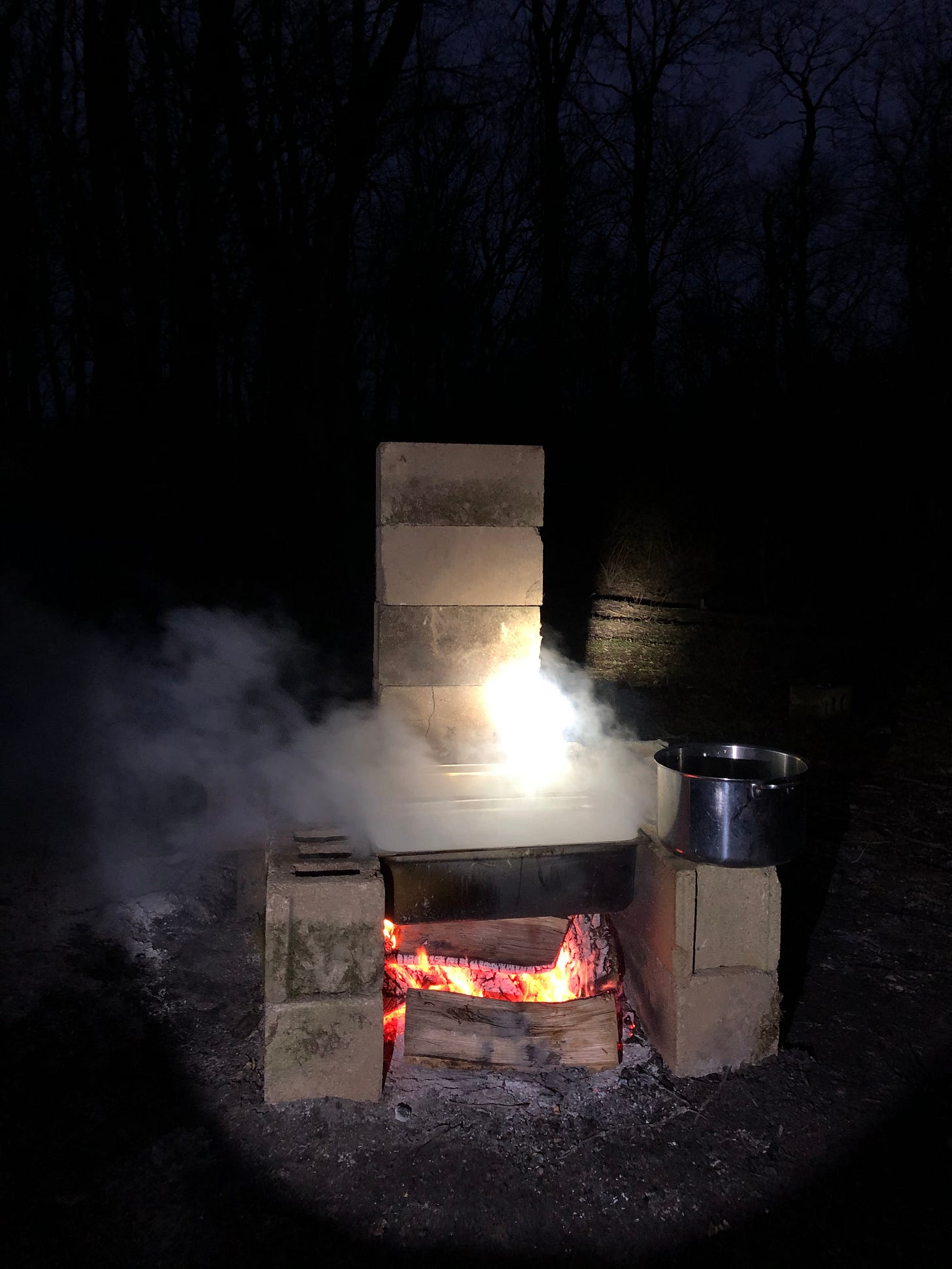Editor’s note: Starting today, we’ll be sending a mixture of new how-tos and favorites from the archives on Wednesdays, making sure that you don’t miss a project as the seasons change.
This piece first ran last March. Up where Elliott lives, near Chicago, syrup season is probably still a few weeks out, but we’re already tapping trees here in Cincinnati. Wherever you are, it’s time to take stock of your supplies: taps, buckets, bags, filters, firewood…
You don’t need to spend a lot of money or tap a lot of trees to experiment with maple sugaring. In a good year, one sugar maple can produce between a quart and a half-gallon of syrup, from ten to twenty gallons of sap. Tap just a few trees and you might end up with enough syrup for a year of pancake breakfasts.
A warning to new cooks: Do not boil sap in your kitchen unless you’re only cooking a small amount—and I mean a couple of gallons or less, which is probably less than you’ll get from a single tree in a couple of days. You don’t want all that steam in your house. Find a way to cook outdoors. Before I finally scaled up to a purpose-built evaporator last year, I used a woodstove and then a simple cinderblock pit topped with two hotel pans from a local restaurant supply store (pictured above). Both setups worked for small batches. If cooking over wood isn’t important to you, look for a propane-powered turkey fryer kit.
Need gear? The first time I made maple syrup, I used a handful of taps that I found on Amazon and buckets from Ace Hardware. These days, I get my maple sugaring equipment from my friends at Wisconsin’s Smoky Lake Maple.
By Elliott Papineau
I saw the grass today. It was brown and matted, like a dog coming out of a muddy creek. The frost is still lingering for too long in the morning, but the sun is hanging a little bit higher each day, promising warmer days ahead. Nights are still cold, freezing puddles of meltwater that might cycle between liquid and solid for weeks.
This is maple sugaring weather. That freezing and thawing cycle sends nutrient-rich sap flowing up from roots to branches, where it will soon feed spring growth.
Our season starts with a freezing night followed by a warm, sunny day. We already have all the tools we need to harvest nature’s sweetness. We drill small holes in our maples and insert our metal taps, nudging them just two or three inches into the trees at slight downward angles. We tap the trees’ sunniest, most exposed faces, which yield more sap. Then we attach clear plastic tubing, which feeds the sap into five-gallon plastic buckets through small holes in the lids, excluding bugs and debris.
We collect and consolidate until we get fourteen gallons—our boiler’s limit. Then, my dad watches it cook. He’s the master syrup maker. I’m still learning. The boil is slow, and there isn’t much you can do to improve it without pro-grade equipment. The sap has to reduce forty times, becoming so thick and sweet that it goes seven degrees above the boiling point of water. That take hours—for us, usually about twelve hours.
You can smell the end of the process. The sap, which initially looks, tastes, and smells more or less like water, takes on a sweet, candy-like aroma, perfuming the woods. In the boiling pan, the bubbles begin to look less like the bubbles you see in boiling water and more like bubbles in a fizzy soda. They tighten up.
The final product is just a small fraction of our original harvest. We treat it like gold. We don’t dump it over our breakfast plates. We drizzle the hard-earned syrup onto steaming pancakes and fork up our first bites before we lose even a drop.
The Farm Maple Cream
Use this sweet spread on toast, on pancakes or waffles, in sandwich cookies, or in any kind of pastry. (How about maple cream cinnamon rolls?) The small amount of butter in the recipe keeps the maple syrup from foaming over as it reduces.
Ingredients
2 cups maple syrup
¼ tsp. good butter
Pinch of flaky salt
Preparation
Place a heatproof mixing bowl into a larger bowl filled with ice and water.
Add syrup and butter to a saucepan fitted with a candy thermometer. Bring the mixture to a boil over high heat, without stirring. Continue to heat until the mixture reaches 235°F.
When the mixture hits 235, pour it into the awaiting ice bath and let it cool to 100 degrees, which should take about 10-15 minutes.
Beat the cooled maple with a spoon or pour it into a stand mixer fitted with the paddle attachment. Beat on medium-low until you achieve a spreadable texture, reminiscent of peanut butter. That could take up to 30 minutes.
Store in an airtight container in the refrigerator for up to one year.
Elliott Papineau’s lifelong passion for nature led him, along with his parents Rebecca and Alan, to start The Farm in Bourbonnais, Illinois. He and his wife of eleven years, Kristen, have three kids, Landon, Elise, and Aubrey. He has been featured in the New York Times, the Chicago Tribune, Midwest Living, and Four.






